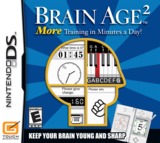The game that launched a new generation of gamers is back! Based on the theories of neuroscientist Dr. Kawashima, Brain
The whole idea behind the Brain Age design is to keep those synapses firing in your head by giving a regular assortment of simple challenges that do nothing more than make you think. The first Brain Age was the first foray into this concept and most of the exercises were pretty straightforward Iowa Test-style challenges. In Brain Age 2, they're a lot more creative with twists applied to challenges that started out in the original version of Brain Age. So while you might have had your fill from last year's 20 dollar mental exercise, there's a lot more where that came from in this year's 20 dollar cart. It's still not real gaming, but there's still fun to be had in brain-bending challenges that you'd expect to find in a middle-school text book.
Gone are the silly tasks like Volume 1's "Read this chapter" challenge that never really put any of the Nintendo DS system's capabilities to use. Also gone is the poorly tested voice recognition where no amount of saying the word "blue" would register properly in the color shouting game. Every game, every challenge has been tightly developed and tested, with the handwriting engine tweaked a bit better and the voice recognition working like a champ.
That one voice recognition challenge shows you just how mentally taxing the tasks can get in Brain Age 2. In it, you have to rapidly shout out "Rock," "Paper," or "Scissors," when you're shown an on-screen fist, hand or set of fingers. Ah, but it isn't that easy…shouting out the winning answer might be a snap, but the designers throw in a curve by randomly forcing you to call out the losing answer. You can feel your brain straining after just thirty seconds of this task. Eventually you'll get it, but boy what a workout the first few dozen tries.
Then comes the math quizzes. Unlike the original, a twist is thrown at the player: as they're answering the simply "2 + 8 = " equation, one number is being scribbled over. And that "mystery" number will be used in the next question, while the other number slowly gets scribbled over as well. It forces you not only to mentally come up with the answer, but also to immediately recall what that number was when you answered the equation. Simple, but clever and very tricky.
The other challenges are equally creative. Like the one where you have to listen to multiple spoken words as they're layered on top of each other, and then spell out the words that you heard. Or following along on a piano as sheet music plays a familiar tune. The "count the men" challenge from last year has been "upgraded" in a clever "what place did the man come in during the race" game of observation. Later you'll unlock this "day of the week" challenge where you'll have to immediately recall what the current day is and then figure out stuff like "What day was two days after and three days before today?" Time travelers beware - this is the designers' way of keeping you from mucking around with the in-game clock.
Everything else, however, remains pretty much untouched in the move from Brain Age to Brain Age 2. Other than a newer color scheme for the menus, the interface in this sequel remains identical to last year's game, and the theme of encouraging daily play through a set schedule of tasks and statistics tracking (as well as ranking by how old your brain is) has not changed one bit. And to supplement the brain bending activities, Nintendo brings back another set of a hundred Sudoku puzzles. Not that big of a deal this time, simply because in the 18 month gap between Brain Age 1 and Brain Age 2 there have been a bazillion Sudoku puzzles released on the Nintendo DS. To its credit, Brain Age 2's Sudoku engine still kicks ass and blows away the rest of the DS Sudoku crowd thanks to the quick and easy interface.
However, the new game has a new addition: multiplayer competition. It was one of the better options in Nintendo's "competing" follow-up, Big Brain Academy, and the inclusion here definitely makes this a worthwhile purchase, just in case you weren't convinced that an additional set of brain strengthening tasks was enough. Up to four players can compete in variations of the tasks wirelessly between systems, and only one copy of the game is needed to play them. If you think doing the tasks solo was taxing, wait until you try to beat other players in rapid-fire challenges.
Closing Comments
In many cases it's tough to praise a company for recycling assets to make a sequel on the handheld. Brain Age 2 definitely has that flavor of a quickly developed product, reusing pieces from the first game to get the second volume out the door while the "Casual Gaming" window is still open. But while the feel is familiar, much of the experience is brand new. With the exception of Sudoku, every brain challenge in this sequel is fresh, and even if you played the first game to death there's a lot more mind-building challenges here, many of which are a lot more fun and addictive than the ones in last year's series premiere.

